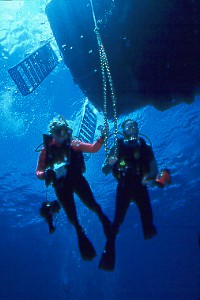We took a 12 night trip on the Bilikki- (there were only 6 of us, and a crew of 11!). The diving begins right outside
of Honiaria, in Iron Bottom Sound- so named for the number of WWII shipwrecks that are there. Most are out of the range
of recreational diving, though. The boat then makes its way to the west/northwest towards the Russell and New Georgia
Islands. From there, we headed to the Florida Islands to complete the circuit. We encountered walls encrusted with soft
corals of many vivid colors, huge expanses of table corals, massive schools of fish, and so many species that are found
only in this part of the world. We also dived several WWII wrecks that, over the last 60+ years, had became so covered
in corals and crinoids, they were hard to recognize. Several kinds of Lionfish, multicolored nudibranchs (snails without
shells), humphead wrasse, pipefishes, anthias, crinoids of varied colors, anemones with varied types of clownfish,
crocodilefish, and schools of fish would abound. Starfish of many colors littered the bottom along with large,
multicolored giant clams.
The reefs were a mecca for macro photography, and other than insanely colorful nudibranchs, the two things I wanted to photograph were
the pygmy seahorse (about the size of a grain of rice) and the mandarin fish. I had hoped to see the mandarinfish
spawning, but knew that would be very difficult. (See the accompanying article on that adventure-
Mandarin Fish Adventure Photography).
I photographed an unnamed species of mantis shrimp, and several species of fish not found in the books. Sometimes
the currents would be ripping, but the visibility was generally pretty good. We did see numerous turtles and some
sharks, mostly black tipped reef sharks.
This was a trip of a lifetime for us, and it re-enforced for us the fact that we have so much of our underwater
world and cultures yet to see and experience. It also reaffirmed to us how much of the world gets by on very little,
and happiness has nothing to do with material things. We plan to go back as soon as we can.
For more information on diving from the liveaboards, contact the Bilikiki at
www.Bilikiki.com
See you there!
___________________________________



